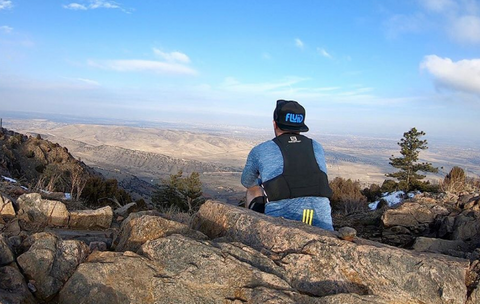
Were you feeling it? That magical time before race season starts, when long runs start to feel like last month’s short runs? When the repetitive rhythm of pedal strokes begins to sound like a PR pace? Then, suddenly, instead of gearing up for a summer of events, we’re stockpiling for a bizarre springtime hibernation. How people spend the next few months of downtime will vary widely, but those lucky enough to have some time, motivation, and space in their days can work at emerging strengthened and satisfied.
First of all, go easy on yourself. None of us have ever had to figure out how to stay fit, financially solvent, personally fulfilled, and in some cases, alive, while staying six feet away from each other at best, or being confined to our house for weeks at a time at worst. Panic isn't productive. The days will come when it’s safe to hug, high-five, and blow snot-rockets on the person behind you in the paceline again (just kidding-don’t do that, even when pacelines are a thing again). It’s all cyclical; You’ll eventually be the same race weapon you once were. If you’re looking for motivation, here are some possible ways to keep your edge and even sharpen it until the starter’s pistol sounds again.
STAY STRUCTURED
An absolutely imperative part of building new habits is creating and maintaining a structure to support your goal. Make no mistake, we’re all forming new habits these days, whether as an inexperienced home-school teacher or an obligation-free wanderer, so claiming time for workouts and sticking to it is critical. You may be able to keep your 5AM session going without problem. Or, you may need to start one, since now you’re teaching homeroom instead of swimming after dropping the kids at school.
IDENTIFY PATTERNS THAT ARE HOLDING YOU BACK
If you log your races and training, now is the time to dive in for a deep analysis. Where do you usually lose time? When is your motivation lowest? Which part of your body starts to hurt on what terrain? Do you put in enough time trying to improve your weaknesses? Once you identify patterns, you can guide workout and recovery time towards areas which need improvement, and the resulting work may not be what you usually expect. Sometimes, the solution isn’t just a function of effort and time.
Say you hate running hills, and find you’re losing considerable time, and sometimes races, because of it. It’s easy just to write off hills as hard for whatever reason: your morphology or your body chemistry, but there may be another explanation inclines have you irritated. Perhaps improving your climb times is as easy as realizing most of your runs are flat, and committing yourself to terrain with steeper uphills, at least for the immediate future. If there is a more complex reason—perhaps subliminally you can’t stand the feeling of working harder and moving slower—uncovering the pattern by analyzing data could help you remove a possible mental block.
SHIFT FOCUS
This is a great time to help yourself lengthen your stride, improve your stance, and increase endurance. Since many usual training areas are now closed—the gym, pool, track, and increasingly trails and beaches—you might have to work with what you’ve got. If cardio and explosivity is out of the question, prioritize flexibility and static strength, which will both contribute to better form and faster race times. Live, online Pilates and yoga classes are now offered by many local studios, and there is no shortage of YouTube videos to help get you started. For runners, Yin yoga, with its sustained positions and deep, gentle stretching, is a great way to open up abused and neglected muscles and joints.
If tensing, lengthening, and following your breath doesn’t hold your attention, you can still heal and improve your body by working the foam roller and massage balls overtime. Dig into those problem areas that hurt too badly to put pressure on after a workout. Slower, longer, self-massage sessions will let you unlock key areas, while relieving some of the stress we’re all experiencing in these days of quarantine.
Finally, challenge yourself to do something you would normally shy away from. If you’re an endurance runner, start doing pull-ups. A road cyclist? Get a BMX bike and learn to bunnyhop bar-spin. Buy yourself a skateboard made for surf-style turning and seek out your neighborhood’s stash of smooth pavement. Trying something new nearly always brings positivity to your life, whether you stick with it or not. Now is the time to shake things up.
TRUST IN YOURSELF & OTHERS
By all means, if you’re able to keep up with your current training program and you feel it’s been working, do it. Also, take an honest look at how you’ve been feeling. Was your shoulder starting to hold you back? Were your usual running trails getting boring? If it’s time to take a break anyway, do it, and lean on the built-in excuse that comes with a worldwide social-distancing edict.
Don’t forget about your friends! Actively stay in touch with family and buddies via phone, video conferencing, social media, or STRAVA (definitely join Fluid’s STRAVA club for some friendly competition and insider benefits). Asking a trusted training partner what they view as an area you could improve in comes from a perspective you may be unable to see. Be careful here though; Asking someone to critique you on something as personal as your physical performance may put them in an awkward spot. Make sure each of you is comfortable with speaking out and taking constructive criticism.
Remember, every day that goes by brings us that much closer to getting back to jobs, school, recreation, and training and competing. With luck, and by continuing to make conscious, informed decisions about how to spend our time, we’ll be able to get back to those things we love with sound, even improved, bodies and minds.
Cheers!


